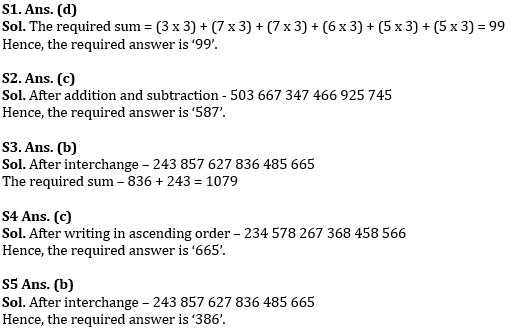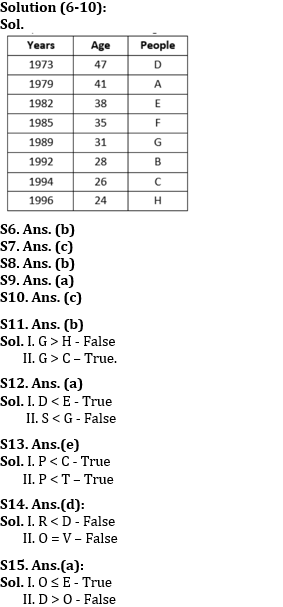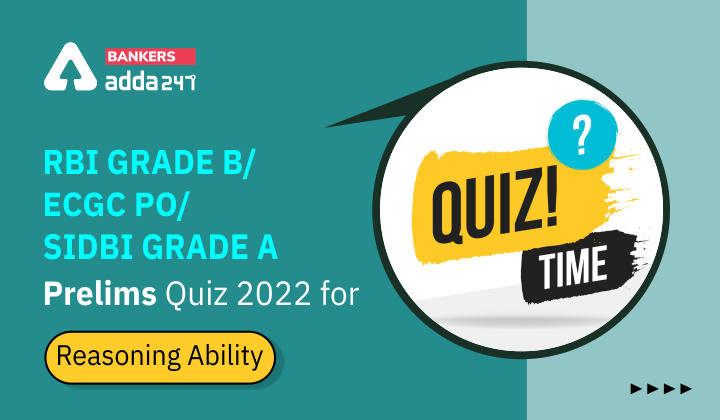Directions (1-5): Study the following data carefully and answer the questions accordingly.
423 587 267 386 845 665
Q1. If the last digit of each number is multiplied by 3 then what will be the sum of the resultant of all the digits after multiplication?
(a) 94
(b) 104
(c) 114
(d) 99
(e) None of these
Q2. If we subtract 2 from the second digit of each number and add 1 to the first digit of each number, then which of the following will be the third highest number?
(a) 423
(b) 665
(c) 587
(d) 386
(e) None
Q3. If the first two digits of each number are interchanged then what will be the resultant of the sum of the lowest and the second highest number?
(a) 1132
(b) 1079
(c) 1010
(d) 1099
(e) None of these
Q4. If all the digits in each number are written in ascending order within the number, then which of the given number will become the second highest?
(a) 587
(b) 386
(c) 665
(d) 845
(e) None of these
Q5. If the first two digits of each number are interchanged then which of the following number will be second highest?
(a) 267
(b) 386
(c) 423
(d) 587
(e) None of these
Directions (6-10): Study the following information carefully and answer the given questions.
Eight people i.e. A, B, C, D, E, F, G and H were born in different years i.e., 1996, 1973, 1979, 1985, 1994, 1992, 1982 and 1989 but not necessarily in the same order. (Note: Consider the base year as 2020.) The age of B is a multiple of 7. Three people were born between F and H. One person was born between B and F who was born before B. The difference between the age of H and C is 2 years. Two people were born between G and A who is not the youngest. D was not born after E. The difference between the age of C and G is 5 years.
Q6. Who amongst the following is the oldest person?
(a) G
(b) D
(c) F
(d) H
(e) None of these
Q7. How many people were born between A and the one who was born just after G?
(a) Four
(b) Two
(c) Three
(d) Five
(e) None of these
Q8. What is the age of the one who was born just before E?
(a) 38 years
(b) 41 years
(c) 35 years
(d) 28 years
(e) None of these
Q9. Four of the following five are alike in a certain way and hence form a group. Which is the one that doesn’t belong to that group?
(a) D
(b) E
(c) B
(d) C
(e) H
Q10. Who amongst the following was born in 1992?
(a) H
(b) D
(c) B
(d) E
(e) None of these
Directions (11-15): In each of the following questions, assuming the given statements to be true, find which of the following options holds true:
Q11. Statements: F ≥ H, A ≤ C, G ≥ H, H > C
Conclusions:
I. G > H
II. G > C
(a) If only conclusion I is true.
(b) If only conclusion II is true.
(c) If either conclusion I or conclusion II is true.
(d) If neither conclusion I nor conclusion II is true
(e) If both conclusions I and II are true.
Q12. Statements: J ≤ K, S > D < T, E ≥ S, E = G
Conclusions:
I. D < E
II. S < G
(a) If only conclusion I is true.
(b) If only conclusion II is true.
(c) If either conclusion I or conclusion II is true.
(d) If neither conclusion I nor conclusion II is true
(e) If both conclusions I and II are true.
Q13. Statements: T ≥ M, M < K, C = K, P < M
Conclusions:
I. P < C
II. P < T
(a) If only conclusion I is true.
(b) If only conclusion II is true.
(c) If either conclusion I or conclusion II is true.
(d) If neither conclusion I nor conclusion II is true
(e) If both conclusions I and II are true.
Q14. Statements: R > S < O ≥ C, S = V > D ≥ A
Conclusions:
I. R < D
II. O = V
(a) If only conclusion I is true.
(b) If only conclusion II is true.
(c) If either conclusion I or conclusion II is true.
(d) If neither conclusion I nor conclusion II is true
(e) If both conclusions I and II are true.
Q15. Statements: D < E ≥ C = V > G ≤ T, C ≥ O
Conclusions:
I. O ≤ E
II. D > O
(a) If only conclusion I is true.
(b) If only conclusion II is true.
(c) If either conclusion I or conclusion II is true.
(d) If neither conclusion I nor conclusion II is true
(e) If both conclusions I and II are true.
Solutions





 GA Capsule for SBI Clerk Mains 2025, Dow...
GA Capsule for SBI Clerk Mains 2025, Dow...
 The Hindu Review October 2022: Download ...
The Hindu Review October 2022: Download ...
 SBI Clerk Prelims Result 2025 Out, Direc...
SBI Clerk Prelims Result 2025 Out, Direc...







